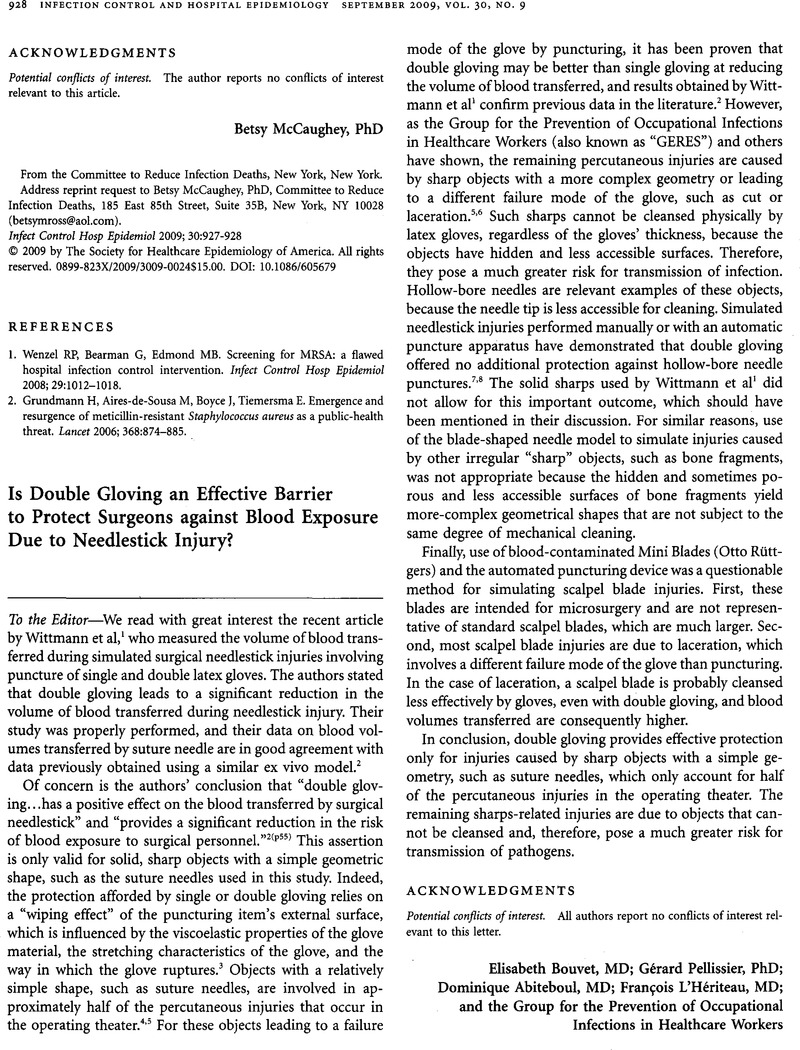Crossref Citations
This article has been cited by the following publications. This list is generated based on data provided by Crossref.
Wittmann, Andreas
Kralj, Nenad
and
Hofmann, Friedrich
2009.
Reply to Bouvet et al.
Infection Control & Hospital Epidemiology,
Vol. 30,
Issue. 9,
p.
929.
Wittmann, Andreas
Kralj, Nenad
Köver, Jan
Gasthaus, Klaus
Lerch, Hartmut
and
Hofmann, Friedrich
2010.
Comparison of 4 Different Types of Surgical Gloves Used for Preventing Blood
Contact.
Infection Control & Hospital Epidemiology,
Vol. 31,
Issue. 05,
p.
498.
Korniewicz, Denise
and
El‐Masri, Maher
2012.
Exploring the Benefits of Double Gloving During Surgery.
AORN Journal,
Vol. 95,
Issue. 3,
p.
328.
Edmiston, Charles E.
Zhou, S. Steve
Hoerner, Pierre
Krikorian, Raffi
Krepel, Candace J.
Lewis, Brian D.
Brown, Kellie R.
Rossi, Peter J.
Graham, Mary Beth
and
Seabrook, Gary R.
2013.
Evaluation of an antimicrobial surgical glove to inactivate live human immunodeficiency virus following simulated glove puncture.
Surgery,
Vol. 153,
Issue. 2,
p.
225.
Cleveland, Kevin B.
2013.
Campbell's Operative Orthopaedics.
p.
706.
Mischke, Christina
Verbeek, Jos H
Saarto, Annika
Lavoie, Marie-Claude
Pahwa, Manisha
and
Ijaz, Sharea
2014.
Gloves, extra gloves or special types of gloves for preventing percutaneous exposure injuries in healthcare personnel.
Cochrane Database of Systematic Reviews,
Vol. 2014,
Issue. 3,
Walczak, Dominik
Grajek, Maciej
Pawełczak, Dariusz
Żółtaszek, Agata
Szumniak, Ryszard
Czarnecki, Marek
Trzeciak, Piotr
Krakowczyk, Łukasz
Maciejewski, Adam
and
Pasieka, Zbigniew
2020.
Do surgeons use double gloves during surgery? Results
of a survey.
Polish Journal of Surgery,
Vol. 93,
Issue. 1,
p.
9.
Parlak, Emine Arici
Ilkaz, Neslihan
Ayhan, Hatice
and
Iyigun, Emine
2025.
Comparison of the effect of glove size on comfort, sensitivity and dexterity in the use of double surgical gloves: a randomized controlled trial.
International Journal of Occupational Safety and Ergonomics,
p.
1.



